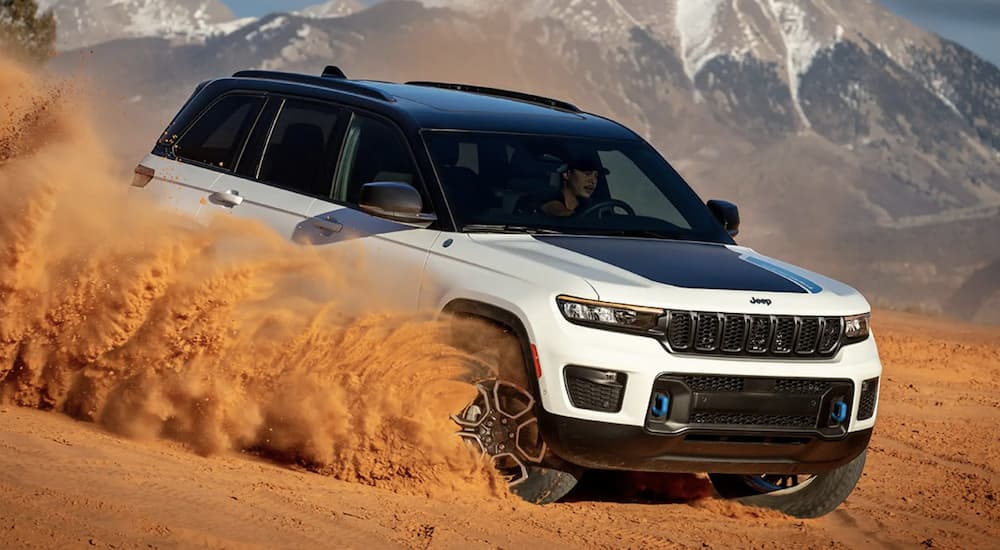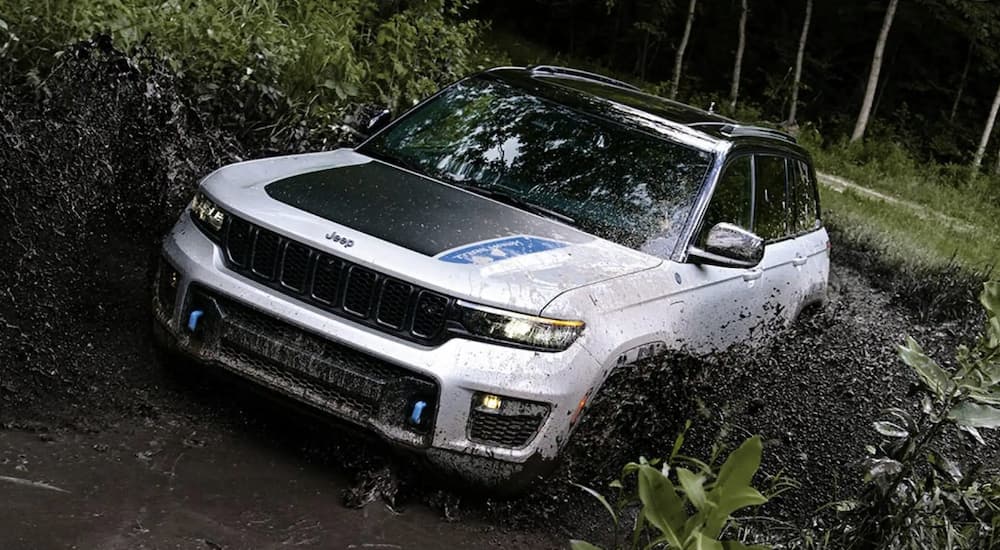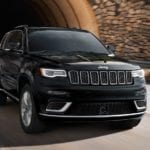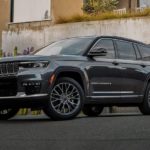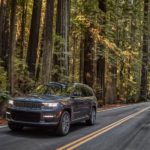Do you know of any other vehicle that’s literally broken glass with its debut? That’s the legacy of the Grand Cherokee. Ford debuted the Explorer in 1990, igniting fierce competition in the SUV segment as automakers like Jeep rushed to offer a rival. By 1992, Jeep had its answer with the Grand Cherokee, a luxurious spinoff of the Cherokee that proved rugged adventurers didn’t have to be rugged at all. The Grand Cherokee made a lasting impression at the Detroit Auto Show as it drove up the steps of Cobo Hall and smashed through the convention center window, leaving everyone aghast.
Today, the 2023 Jeep Grand Cherokee two-row proves that adventures can be luxurious as the latest iteration of the most awarded SUV ever made. How far has the Grand Cherokee come over the years? To truly appreciate the 2023 Grand Cherokee requires taking a drive down memory lane to the models that started it all.
Grand Cherokee ZJ: 1992-1998
The Grand Cherokee made a smashing debut at the 1992 Detroit Auto Show, arriving as a 1993 model. Available in three trims (Base, Laredo, and Limited), the Grand Cherokee was larger and more luxurious than the Cherokee but just as capable with its part-time Command-Trac or full-time Select-Trac four-wheel drive systems. It shared the Cherokee’s 4.0L straight-six engine that churned out 190 horsepower but added standard luxuries like a driver’s airbag, a first for the segment.
Over the next six years, the Grand Cherokee carved its place in the Jeep family as it balanced luxury with capability. Jeep introduced more power via the 220-horsepower 5.2L V8 engine and made four-wheel-disc brakes standard across the lineup. In addition, the revolutionary Quadra-Trac four-wheel drive system debuted on the Orvis edition in 1995, ushering the Grand Cherokee into a new era of capability on and off the pavement.
How It Started vs How It Ended:
- 1992 Powertrain: 4.0L straight-six (190 hp)
- 1998 Powertrains: 5.2L V8 (220 hp) or 5.9L V8 (245 hp)
Grand Cherokee WJ: 1999-2004
1999 marked the introduction of the second-generation Grand Cherokee, codenamed the WJ. Taller, wider, and longer than its predecessor, the redesigned Grand Cherokee handled better thanks to a modified rear suspension and updates to the powertrain, including the swap between the 5.2L for the 235-horsepower 4.7L V8. Beyond this, Jeep introduced the Overland as the SUV’s top-tier trim, outfitting the model with a high-output V8, leather trim, 17-inch wheels, an updated suspension, and real wood accents.
The Grand Cherokee welcomed several special edition models throughout the generation to celebrate its widespread success. The 60th Anniversary Edition debuted in 2001 as a black or silver model with an exclusive two-tone leather interior and chrome wheels. It was followed by the introduction of the Laredo Sport and Special Edition in 2002, which were both discontinued by 2003. That gave Jeep more room to introduce several special edition models, including the Rocky Mountain Edition, Special Edition, Freedom Edition, and Columbia Edition. Coincidentally, the 2004 Grand Cherokee also debuted the first-ever Trail Rated badge.
How It Started vs How It Ended:
- 1994 Powertrains: 4.0L straight-six (195 hp), 4.7L V8 (235 hp), 4.7L high-output V8 (265 hp)
- 2004 Powertrains: no changes
Grand Cherokee WK: 2005-2010
Following a five-year redesign trend, Jeep introduced the Grand Cherokee’s third generation in 2005 as the WK. The new model turned heads among Jeep fans because it marked the first time Jeep implemented rack-and-pinion steering and an independent front suspension. The result was phenomenal, especially with three available four-wheel drive systems (Quadra-Trac I, Quadra-Trac II, and Quadra-Drive II).
Over the next five years, the Grand Cherokee saw ongoing improvements and the addition of new technology like a rear-seat DVD player. These additions were accompanied by the debut of the sport-inspired SRT8 in 2006, a HEMI-powered road warrior capable of churning out 420 horsepower and 420 lb-ft of torque for a launch from 0 to 60 mph in under five seconds. Fortunately, Jeep didn’t stop there and reintroduced the opulent Overland with a 5.7L HEMI V8 under the hood.
During this time, Jeep tinkered with its 3.0L V6 diesel powerplant, initially offering it on the Limited and Overland trims. Although Jeep increased its output and added the Laredo to its lineup, the diesel option was discontinued shortly after. Why the quick turnaround? Jeep updated the 5.7L HEMI to 357 horsepower and 389 lb-ft of torque and the 4.7L V8 to 305 horsepower, leaving the diesel lost in the shuffle.
How It Started vs How It Ended:
- 2005 Powertrains: 3.7L V6 (210 hp), 4.7L V8 (230 hp), 5.7L HEMI V8 (325 hp)
- 2010 Powertrains: 3.7L V6 (210 hp), 5.7L HEMI V8 (357 hp)
Grand Cherokee WK2: 2011-2020
The 2011 Grand Cherokee, codenamed WK2, marked a significant shift for the SUV as Jeep raised its standards of capability and luxury. Jeep finetuned the geometry of the independent suspension and added a new terrain management system, giving drivers a choice between drive modes (Auto, Sport, Rock, Sand/Mud, and Snow) for a customizable experience on any terrain. Jeep also improved the SUV’s ride quality and handling with the Quadra-Lift air suspension that continuously adapted to the landscape, proving bumpy rides don’t have to be so rough after all.
These improvements and numerous others, including the return of the SRT8 in 2012, earned the Grand Cherokee a coveted honor as the most awarded SUV in history. Jeep celebrated as much with the addition of the Grand Cherokee Trailhawk, a beefier adventurer with skid plates and off-road tires that set the stage for the 2018 Trackhawk. While the Trailhawk was destined to get a little mud on the tires, the Trackhawk was designed for the pavement with its 6.2L supercharged hellcat V8 engine under the hood churning out 707 horsepower and putting a permanent smile on any driver’s face.
How It Started vs How It Ended:
- 2011 Powertrains: 3.6L Pentastar V6 (290 hp), 5.7L V8 (360 hp)
- 2020 Powertrains: 3.6L Pentastar V6 (295 hp), 5.7L V8 (360 hp), 6.4L V8 (475 hp), 6.4L Supercharged V8 (707 hp)
The Newest Iteration of the Grand Cherokee (And What It Means for Jeep)
The latest iteration of the Grand Cherokee debuted in 2021, reintroducing the SUV as a bigger, better, and bolder version of its predecessor. But the 2023 Grand Cherokee does something even more critical. It embodies Jeep’s acute awareness of what drivers want and need in the best-selling SUV. How so?
The 2023 Grand Cherokee is available as a two-row, three-row, or hybrid SUV. This wide variety gives drivers a broad spectrum of choices to find the perfect model for their driving needs. Perhaps even more impressive is that every model introduces a new suite of technology that complements the Grand Cherokee’s exceptional capability and prowess on and off the pavement. For example, in the 2023 Grand Cherokee two-row, this technology includes an expansive 10.1-inch Uconnect 5 NAV system that offers smartphone integration and an array of in-vehicle apps to make your time in the driver’s seat more enjoyable than ever.
Beyond technology, the Grand Cherokee builds on its longstanding tradition of power and performance. The award-winning 3.6L Pentastar V6 and 5.7L V8 engines are at home in the lineup, delivering anywhere from 293 to 357 horsepower in the blink of an eye. Staples like the Selec-Terrain traction management system, the legendary four-wheel drive systems, and the Quadra-Lift air suspension pay homage to the Grand Cherokee’s roots and continue to showcase Jeep’s exceptional ability to blend rugged capability with effortless handling and next-level comfort. That’s how Jeep and the 2023 Grand Cherokee shatter the proverbial glass ceiling in a segment where luxury and capability are often mutually exclusive.
